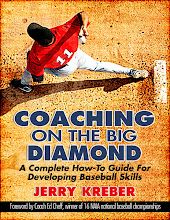Tuesday, February 21, 2006
Pitching Series: Part II


Stage Two:
Pelvic Loading
Once the leg lift occurs, the pitcher not only loads their rear leg, but hips as well. Loading the hips is a difficult movement because it involves controlling the pelvis to move, but in a way that does not throw the pitcher off line toward the target. As the pitcher reaches the top of the leg lift, to load their hips they must turn the pelvis away from the hitter. When a pitcher turns the pelvis away from the hitter, they show the batter their glove side back pocket. From a side view, the pitcher looks as if they place their glove foot parallel to their pitching foot.
There are two reasons why pelvic loading can help generate force off the mound. First by turning the pelvis away, the pitcher, can apply more force over time with the lower body going into foot plant. By increasing momentum with the lower body, pitchers will take stress off the arm by allowing it to “go along for the ride” so to speak. Secondly, muscles can only work when they are properly loaded. If no load occurs, the muscle cannot properly help perform an action. For instant, a person cannot jump on legs already extended. To achieve maximum muscle use while jumping, a person must have flexion in the legs and explode to extension. If a pitcher wants to use their hips during the pitching motion, they must be loaded back and then extended forward.

On this page, there are three pictures that illustrate pelvic loading actions. On the left, Greg Maddux is completing his leg lift. From the front, Maddux is showing the hitter his back glove-side pocket. In this position, Maddux has shown a slight turn in the pelvis. In the middle, Pedro Martinez displays the parallel position of the throwing and glove leg on the lift. By turning his glove foot to parallel, Martinez has loaded his hips to produce strong momentum toward the plate. Steve Carlton, on the far right, displays both of the pelvic loading points referred to in the above information. From this angle, it presents a clear picture of his back pocket along with the glove foot to parallel. One extremely important point to remember is that although the hips have slightly turned, the glove shoulder stays in a straight line with the target.
There are two reasons why pelvic loading can help generate force off the mound. First by turning the pelvis away, the pitcher, can apply more force over time with the lower body going into foot plant. By increasing momentum with the lower body, pitchers will take stress off the arm by allowing it to “go along for the ride” so to speak. Secondly, muscles can only work when they are properly loaded. If no load occurs, the muscle cannot properly help perform an action. For instant, a person cannot jump on legs already extended. To achieve maximum muscle use while jumping, a person must have flexion in the legs and explode to extension. If a pitcher wants to use their hips during the pitching motion, they must be loaded back and then extended forward.

On this page, there are three pictures that illustrate pelvic loading actions. On the left, Greg Maddux is completing his leg lift. From the front, Maddux is showing the hitter his back glove-side pocket. In this position, Maddux has shown a slight turn in the pelvis. In the middle, Pedro Martinez displays the parallel position of the throwing and glove leg on the lift. By turning his glove foot to parallel, Martinez has loaded his hips to produce strong momentum toward the plate. Steve Carlton, on the far right, displays both of the pelvic loading points referred to in the above information. From this angle, it presents a clear picture of his back pocket along with the glove foot to parallel. One extremely important point to remember is that although the hips have slightly turned, the glove shoulder stays in a straight line with the target.
